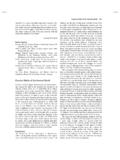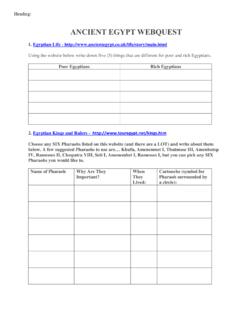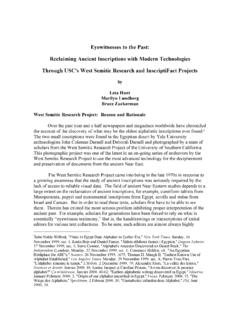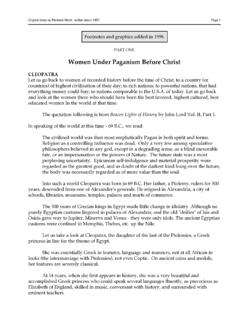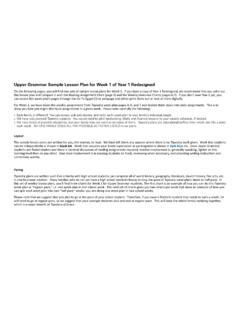Transcription of Trade in the Ancient Near East: Lagaš, Ur, Larsa, Mari
1 Journal of Management and Marketing Research Volume 19, July, 2015 Trade in the Ancient , Page 1 Trade in the Ancient Near east : Laga , Ur, Larsa, Mari M. Wayne Alexander Minnesota State University Moorhead William Violet Minnesota State University Moorhead ABSTRACT Whether trading for the palace, temple, other merchants, or on one s own account, Mesopotamian merchants traveled to distant cities in search of profitable dealings. Sumerian Laga , Ur, and Larsa, and Akkadian Mari merchants transported goods by donkey caravan, river boat, and sea-going ship. They reached Tilmun in the Persian Gulf, Magan in present day Oman, Melu a in the Indus Valley, Emar, Ebla, and Aleppo far to the north, E nunna and Ugarit on the Mediterranean Sea, and Elam in the east . Damkara imported and exported building materials, precious stones, edible oils, ivory, tin, large quantities of copper, woolen garments and cloth, barley, and other grains. Palaces acquired food for their citizens and copper and tin to manufacture tools and weapons of war.
2 Temples obtained the goods needed to conduct both scared rites and secular commercial operations. Merchants grew wealthy and influential. Kings made war on each other, and they and their city-states rose and eventually declined. But without extensive trading activities a king s success and the success of his city-state would have been unlikely. Keywords: Trade in the ANE, ANE Traders, Damkara, Laga , Ur, Larsa, Mari Copyright statement: Authors retain the copyright to the manuscripts published in AABRI journals. Please see the AABRI Copyright Policy at Journal of Management and Marketing Research Volume 19, July, 2015 Trade in the Ancient , Page 2 INTRODUCTION As soon as people need more than they themselves, their family, or their community can provide, they go in search of the articles they need and aim to acquire them by the exchange of articles of equal value. From this moment Trade is born. (Leemans, 1960, p. 1) Ancient Mesopotamia began at the Persian/Arabian Gulf and extended north and west to include the Euphrates and Tigris Rivers, the tributaries flowing into the two rivers, and the river valleys.
3 The Fertile Crescent included Mesopotamia, took in the territory west to the Mediterranean Sea coast and then South into Egypt. For maps see Schomp (2004, p. 9). It encompassed all or part of the modern countries of Iran, Iraq, Turkey, Syria, Lebanon, Jordan, Israel, and Egypt. It is commonly referred to as the Ancient Near east (ANE) (Kuhrt, 1995, ; Snell, 1997, p. ix). Farming developed in the northern foothills of the Fertile Crescent by 9,000 BCE. By 5500 BCE people had migrated south and established settlements in Southern Mesopotamia. By the fourth millennium two cultures flourished near the Persian Gulf: Sumer on the gulf and Akkad to the north (Snell, 1997, pp. 11-14; Schomp, 2004, pp. 6-7). Soil deposited by the Euphrates and Tigris rivers as they flowed south from northern and eastern mountains into the gulf gave Sumer an alluvial topography. Sumerian farmers developed irrigation systems to water their fields. A checkerboard comprised of irrigated, cultivated land and desert used for sheep grazing resulted.
4 The northern terrain of Akkad consisted of broken limestone interspersed with shallow valleys and low hills. The rolling hills meant irrigation was not feasible so farmers depended upon rainfall to water their crops. Cultivation spread into the desert on a line of the diminishing rainfall contour (Postgate, 1994, pp. 14, 18). Desert stretched west from Sumer and Akkad; to the east rose the Zagros Mountains. Land between the two areas remained uncultivated; it received little rain and irrigation was out of reach. Travel between them was limited to two or three routes that offered ease of traverse and water for livestock. Isolated from one another the citizens of Sumer and Akkad initially had little contact. But though they had their own political, military, language, and cultural traditions they shared a lifestyle based upon farming and the raising of sheep and goats (Postgate, 1994, p. 18). Within each, city-states developed including Laga , Ur and Larsa in Sumer and Mari and Babylon in Akkad.
5 As their populations increased, cities needed goods they neither grew nor manufactured. The south lacked trees for lumber and stones for building. Northern cities needed agricultural products such as manufactured woolen cloth, barley, and oil. Thus from the earliest times of civilization Trade went on between cities in the north and south and beyond. By the early third millennium traders traveled in long distance commerce between city-states. Ancient traders bought, sold, transported, and stored goods. Their risks included physical harm, changing consumer wants, and disruptions from war between cities. They developed financing schemes and performed informal customer research. Kings recognized that these trading activities provided necessary goods to their subjects and supported the evolving merchant class (Leemans, 1968, p. 179; Postgate, 1977, pp. 10, 14, 72-75). This paper describes Trade and traders in Sumerian Laga , Ur, and Larsa and Akkadian Mari during the third and second millenniums.
6 A review of Trade in Ancient Mesopotamian Sumer and Akkad may provide insights for 21st century marketers. After all, the economic structures that exist today also existed in prototype forms several thousand years ago (Moore and Lewis, 1999, p. 17). Journal of Management and Marketing Research Volume 19, July, 2015 Trade in the Ancient , Page 3 Three issues limit our discussion. First, evidence of Ancient Trade comes from the unearthed remains of early dwellings and burial sites, carved stone stele commissioned by Ancient kings, and Cuneiform writing on clay tablets. Thousands of unearthed tablets contain inventories, promissory notes, deeds of sales, wills, marriage contracts, court decisions, and literary works (Kramer, 1963, pp. 21-24). However, these sources represent only specific periods of time and describe only some events. Other times and events may differ (Lambert, 1977, p. i). An exhaustive treatment of Trade is therefore not possible. See Kuhrt (1995, pp. 7-12) for an extended explanation.
7 Second, scholars have translated many of the no longer extant languages found on clay tablets into English, German, French, Italian, and several others. But difficulties arise in translation because the idioms in the Ancient languages may not have precise expressions in the modern languages (Leemans, 1960, pp. 1-2 notes). Moreover the material used here draws upon both English translations of the tablets and of English translations of these other modern language translations of the Ancient languages. Leemans provides a discussion of issues involved in translating from translations (1968, pp. 171, 189-191). Third, archeologists have dated events in the ANE using Ancient Egyptian, Assyrian, Babylonian and Sumerian king lists. For examples, see Kramer (1963, pp. 328-331). While these documents record the succession of kings and the lengths of their reigns they create only relative chronologies. They tell us that R m-S n I ruled for 60 years, but they don t give us the actual years according to our modern dating system.
8 Scientists have also turned to new technology to date artifacts such as high-precision accelerator mass spectrometry radiocarbon dating (Renfrew and Bahn, 2010, pp. 120-126). But assigning specific dates remains problematic. This paper uses those dates provided by the sources, some of which follow The Cambridge Ancient History (Postgate, 1994, p. 39). See Huehnergard (1995, pp. 2117-2119) for Semitic languages and their dates, Lemche (1995, pp. 1202, 1210-1212) for lists of rulers and their dates in Ancient Syria and Palestine, and Bertman (2003, pp. 54-59) for historical dates. Because all the dates cited are approximate, circa is used sparingly. And since all the dates are Before the Common Era, BCE is omitted. LAGA In the late third millennium Sumerians established Laga northwest of the junction of the Euphrates and Tigris rivers. Thousands of clay tile records excavated at Laga provide evidence from the reign of Ur-Nan e (ca. 2550). The cuneiform writing state that traders imported precious stones, wood, gold, ivory, dates, onions, and copper from Tilmun (Kramer, 1963, pp.)
9 53, 283). Records from the early twenty-fourth century also mentioned kings Lubalanda (ca. 2390) and UruKAgina (ca. 2380) whose merchants imported copper through Tilmun in exchange for wool, silver, fat, milk, and cereal products (Potts, 1995, p. 1453). Tilmun, also spelled Dilmun and Telmun, likely referred to an island in the Persian/Arabian Gulf off the coast of modern Saudi Arabia, today s Bahrain. Note that Tilmun produced neither copper nor wood but imported them from Magan and Melu a and then sent them north. The probable location of Magan was the Arabian Peninsula in modern Oman. Melu a, also spelled Melukkha, likely referred to the Indus Valley. Melu a also imported and sent on ivory and precious woods (Leemans, 1960, pp. 9, 33-34). Indeed, so close was the relationship between traders of Tilmun and Melu a that Tilmun used the same system of Journal of Management and Marketing Research Volume 19, July, 2015 Trade in the Ancient , Page 4 weights and measures as that found in the Indus Valley (Muhly, 1995, p.
10 1506). See Potts for a discussion of Tilmun, Magan, and Melu a locations (1995, pp. 1453-1458). For several hundred years Laga kings battled neighboring city-states over territory. As rulers redirected resources to warfare its temples and public buildings fell into disrepair. Gudea (2141-2122), one of a number of city-state rulers competing for power in the area, swept down from the Zagros hills and conquered the city. Rather than destroy it, he repaired the Laga temples and public structures (Roux, 1992, p. 166; Charpin, 1995, p. 811). To secure needed building materials Laga traders imported cedars and boxwood from Amanus, stones from the mountains of Amurru, (west of the Euphrates), copper and gold from Melu a, and diorite from Magan (Leemans, 1960, p. 11-12). But battles continued and the city subsequently fell to the king of Ur, Ur-Nammu (2112-2095). UR Ur-Nammu first conquered Ur, then Laga , then went on to overcome other nearby towns and cities.










